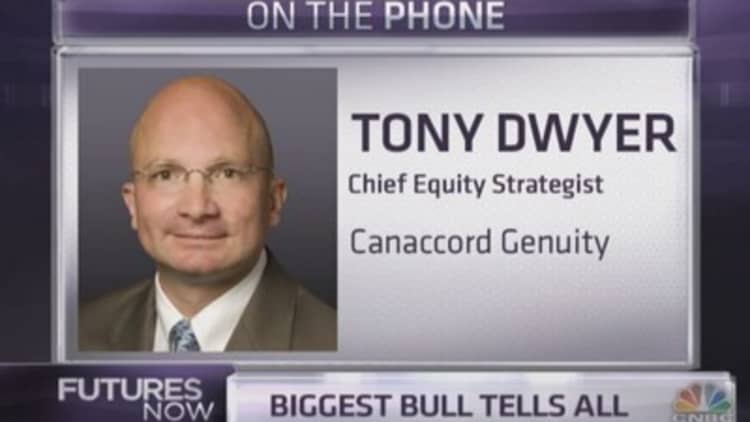
With an S&P 500 year-end target of 2,185, Canaccord Genuity chief equity strategist Tony Dwyer expects the market to close the year more than 11 percent above current levels — technically making him the most bullish strategist on Wall Street. But that doesn't mean he advises buying in now.
In fact, Dwyer is calling for a 5 to 10 percent correction in the near-term, after which he sees the market resuming its upward climb.
"The fundamental backdrop is terrific," he said. "I just think the market is too extended and typically, at this point, it should pull back."
Read More Earnings expectations are driving stocks this year
What's notable is that Dwyer makes this call without a specific catalyst in mind.
"In real bull markets, it's the unknown unknowns that come in and cause a 5 to 10 percent correction," he said. "It's just that when the market gets very tired and it gets extended, you don't know what's going to cause it, but it comes in, and I think that's what we're set up for."
Dwyer knows there's a risk that stocks just continue higher unabated. Yet, he still says that waiting for a correction before buying is worth it because the decline will more than erase any pre-correction gains.
"In the first six months of a new Fed chair, the market pulls back a median 9 percent. When the market's up this long over the 200-day moving average, before you get another 5 percent, you typically get a 7 percent correction, so there's a lot of different quantitative historical nuances that command staying with a correction call, even if it's against you right now."
But Dwyer still advises against doing something as rash as shorting the market. In fact, his main concern is actually that the coming correction will scare away those who really should be in equities.
Read MoreDow's7 underperformers—time to buy?
"Our only point is, with the fundamental backdrop known, I've got to convince our institutional clients that you want to be a buyer, because when corrections come, they're only considered natural, normal, or healthy until they happen. And at that point, everyone fears that it's a fundamental change. [But] I don't think that's going to be the case," Dwyer said.
Rather, for this bullish strategist, a 5 to 10 percent market decline will be natural, healthy and a very attractive buying opportunity.
—By CNBC's Alex Rosenberg
Watch "Futures Now" Tuesdays & Thursdays 1 p.m. ET exclusively on FuturesNow.CNBC.com!



